 A BRIEF
HISTORY: PRIMORSKY KRAI A BRIEF
HISTORY: PRIMORSKY KRAI |
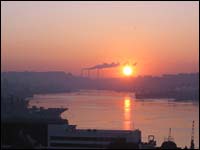
Primorsky Krai's first town, Vladivostok,
was founded in 1860, when Tsarist soldiers landed
in the Golden Horn Bay and set up their military
post. The fast-growing town attracted entrepreneurs
from Europe and America, thanks to its proximity
to China and Japan, and its abundance of natural
resources and Chinese and Korean immigrants providing
cheap labour.
Just 18 years later, the city had over 4,000
residents, mostly living in wooden cottages, but
successful businessmen built stone mansions. The
city had a multi-ethnic flavour, and its main
streets were named Koreyskaya (Korean), Pekinskaya
(Peking) and Kitayskaya (Chinese).
The first industries were logging, fishing for
seafood, gathering ginseng and cedar nuts and
whaling, but settlers also found coal, iron and
gold. The region opened up to commerce with Europe
after the completion of the Trans-Siberian Railroad
from Moscow to Vladivostok in 1903.
By the time of the Bolshevik Revolution in 1917,
Primorsky Krai had 307,000 residents, mainly living
in the official capital Vladivostok, and Nikolsk-Ussurisky
(now Ussurisk).
Communists took power in the remote Far Eastern
city in 1917, but were soon defeated by a coalition
of interventionist forces from Japan, the USA
and other countries.
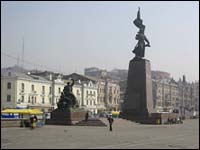
In 1920, Vladivostok was included in a new Far
Eastern Republic, which was democratic, although
it had some control from Moscow, Japanese troops
continued to patrol the city.
As the last outpost of non-Soviet power, Vladivostok
protected many people fleeing from the Bolsheviks,
including the composer Sergei Prokofiev, and the
city's population began to mushroom.
However Allied intervention in the Far East petered
out as the Bolsheviks gained ground and Soviet
control was established over the region in 1922.
In the 1920s the lack of border proficient controls
allowed thousands of Koreans to immigrate to Primorsky
Krai, and Chinese immigrants also came as seasonal
workers, making up 5-10 percent of the population.The
cheap labor was used in agriculture and mining.
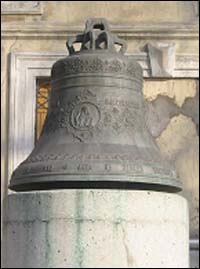
But the 'Iron Curtain' fell at the beginning
of the 1930s, with border controls tightened and
private companies closed down. In 1929 a section
of the Far Eastern Gulag, or Prison Camp Administration,
was set up in Primorsky Krai. Prisoners worked
on construction, logging and as Dockers. By 1937
there were 70,000 prisoners in the region.
The Stalin era also witnessed 'ethnic cleansing'
in Primorsky Krai. From 1937-1938 all the residents
of Korean origin were deported to Kazakhstan and
Central Asia, and those of Chinese origin were
mainly deported to China. Around 200,000 people
were forced out of the region.
In a further isolationist tactic, in 1948 Vladivostok
Port was closed to Western ships, forcing foreign
traffic for the Trans Siberian Rail Road to off
load at the city of Nakhodka, and only reopened
to shipping in 1990.
In the 1950s Soviet general secretary Khrushchev
proclaimed that Vladivostok should become "a
second San Francisco," and the city grew
rapidly with an explosion of modern apartment
blocks.
In 1992 the city was reopened to visitors, and
now attracts crowds of Chinese tourists to casinos,
local hotels and tours of the historic center.
Vladivostok is the chief cultural center of the
Russian Far East. The city has many educational
institutions, including a local branch of the
Russian Academy of Sciences and the Far Eastern
State University.
 REGIONAL
CONFLICT REGIONAL
CONFLICT |
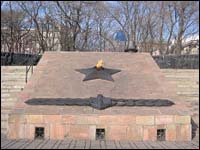
Vladivostok was founded as a military post, and
is now the headquarters of the Russian Pacific Fleet,
meaning that Primorsky Krai has played a major role
in armed conflicts.
During the Russo-Japanese War of 1904-1905, Japanese
warships attacked Vladivostok and local sailors
took part in the defense of Port Arthur, then Russia's
chief base on the Pacific Ocean, in which 28,000
Russian troops died.
After Russia lost Port Arthur to Japan in 1905,
Vladivostok gained strategic significance, and the
Allies stored supplies there during World War I.
Communists took power of Primorsky Krai after the
Bolshevik Revolution in 1917, but were soon defeated
by a coalition of interventionist forces, consisting
mainly of Japanese, but also considerable American,
British, Italian and French troops.
American left-wing journalist Albert Rhys Williams
wrote an eyewitness account in his book 'Through
the Russian Revolution':
'The Japanese seize the powder magazine, the British
the railroad station. The Americans throw a cordon
around the consulate. The Chinese and others take
up lesser points. The Czechs converge upon the Soviet
building. They encircle it from all sides. With
a loud "Hurrah,"---they rush forward,
and go crashing thru the doors. The Red Flag of
the Socialist Republic is pulled down, and the red,
white and blue flag of autocracy is run up. Vladivostok
passes into the hands of the Imperialists.'
The international troops protected the region and
fought against the Bolsheviks in Siberia. |
Their graves can be
seen in Vladivostok's Marine Cemetery, on a hillside
overlooking the city. However by 1922 all the foreign
forces withdrew and the Soviets took power.
During the Second World War, the region's ports
played a major role, as they remained unblocked
by enemy forces. The ships of the Far Eastern
Shipping Company delivered essential aid supplies
from the USA, under the 'lend lease' scheme. Local
factories produced military equipment and shells.
 FAMOUS
PEOPLE FAMOUS
PEOPLE |
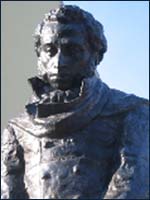
Vladimir Arseniev, 19th century ethnographer
who carried out the first expeditions exploring
Primorsky Krai, using native guides. The regional
museum in Vladivostok is named after him, and
you can also visit his house-museum in the city.
He died in Vladivostok in 1930.
Count Nikolai Muravyov was the governor of Eastern
Siberia and helped secure Primorsky Krai as part
of Russian territory in an 1860 treaty with Peking.
He is buried in the center of Vladivostok.
Yul Brynner - the Hollywood actor, best known
as the bald-headed King of Siam in the musical
film 'The King and I' was born in Vladivostok,
where his father was a wealthy businessman, although
he left as a small child. The family's beautiful
mansion remains in the city centre.
Alexander Fadeyev, a Soviet writer whose works
were compulsory for school pupils studied in Vladivostok
before joining Partisans fighting for Bolshevik
power.
Ilya Lagutenko, the lead singer of popular Russian
rock group Mumy Troll studied at the Far Eastern
State University in Vladivostok, and many of his
songs are dedicated to the city, although he now
lives in London.
Russian traveller Fyodor Konyukhov, who has reached
the South and North Poles and climbed Mount Everest
is an honourary resident of Nakhodka and begins
many of his expeditions in Primorsky Krai.
 RELATIONS
WITH MOSCOW RELATIONS
WITH MOSCOW |
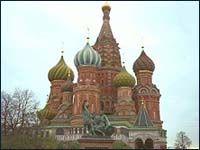
Seven times zones and 9289 km away from the Russian
capital, Primorsky Krai can feel cut off from Moscow.
Indeed, Russians term the region 'the Far East',
while they dub Israel 'the Near East'!
In Soviet times, Lenin spoke of Vladivostok, 'it's
far away, but our town,' and citizens were encouraged
to settle in Primorsky Krai by higher salaries and
apartments. Prices for food and energy were kept
artificially low, despite the need to import agricultural
produce and coal to the region.
Primorsky Krai remains a subsidized region, receiving
more in financial support from Moscow than it gives
in taxes, but prices have rocketed, with a loaf
of bread costing up to twice as much as in Moscow,
and much higher energy tariffs, although local salaries
are far lower than in the capital. Not surprisingly,
young educated professionals dream of leaving for
Western Russia, with a significant 'brain drain'
to Moscow.
Many as a sign of increased attention from Moscow
saw the APEC investment forum in September 2002.
Although President Vladimir Putin did not attend,
he has visited the Far East twice recently, as has
defense minister Igor Ivanov and the chairman of
the Federation Council Sergei Mironov.
 THE CLOSED CITY
THE CLOSED CITY
|
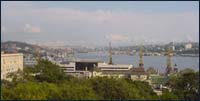
Situated on borders with Korea and China, Primorsky
Krai was a multi-ethnic region before the Bolshevik
Revolution, with up to 40 percent of Vladivostok
residents of non-Russian origin.
However the Stalin regime saw the deportation of
Chinese and Korean immigrants and the tightening
of borders, and in 1948 Vladivostok port was closed
to Western ships due to its military significance.
From then on foreign traffic for the Trans Siberian
Rail Road off loaded at Nakhodka, and Western tourists
traveling the railroad stepped out at Nakhodka,
and were escorted straight to a ferry to Japan.
The city only reopened to shipping in 1990, while
foreign tourists were permitted to visit the city
in 1992.
 THE RUSSIAN NAVEL FLEET
THE RUSSIAN NAVEL FLEET
|

In the 1890s, Vladivostok grew into a large naval
base with steam ships replacing sailing boats, and
became strategically significant after the fall
of Port Arthur in 1905. The Commander-in-Chief of
the ports of the Eastern Ocean and the Siberian
the ports of the Eastern Ocean and the Siberian
Flotilla lived in a stone mansion on Svetlanskaya
Street built in 1895.
Russian Submarine Museum
The first ship of the Soviet Pacific Fleet is preserved
as a museum in Vladivostok harbour. Named Krasny
Vympel, or Red Pennant, the small ship was launched
in Peterburg in 1911 as part of the Tsarist fleet,
but was taken over by Bolshevik forces in 1917.
In the 1920s and 1930s, the Pacific Fleet gained
torpedo boats, submarines and seaplanes. During
Soviet times, Vladivostok's activities centered
around the Fleet, with large ship repair and defense
factories. The headquarters of the Pacific Fleet
stands on the quayside, next to a beached WWII submarine,
which is now a museum.
The region retains many naval bases, although many
are poorly maintained due to lack of central funding,
and sailors in full uniform are a common sight on
Vladivostok's streets.
|

